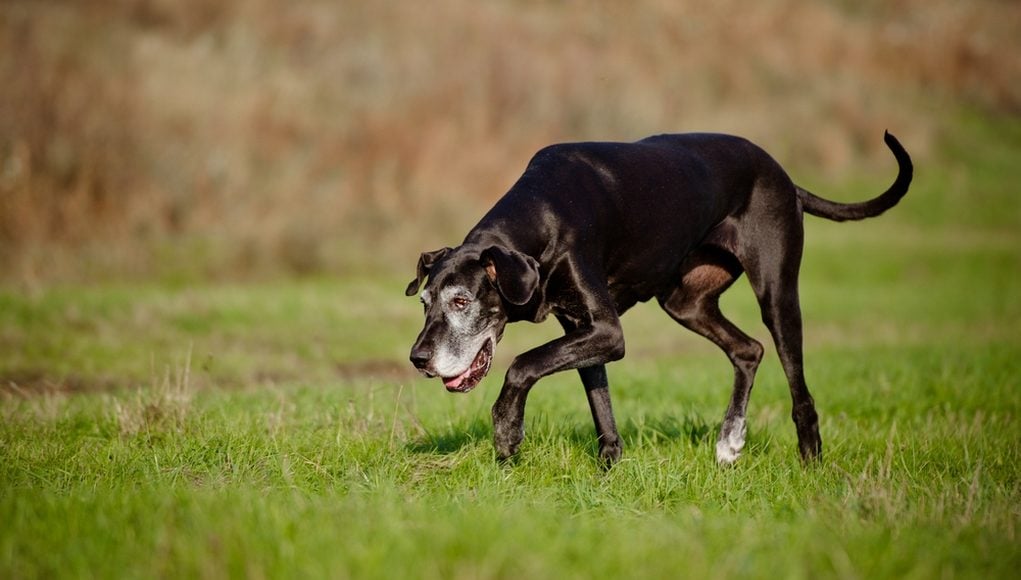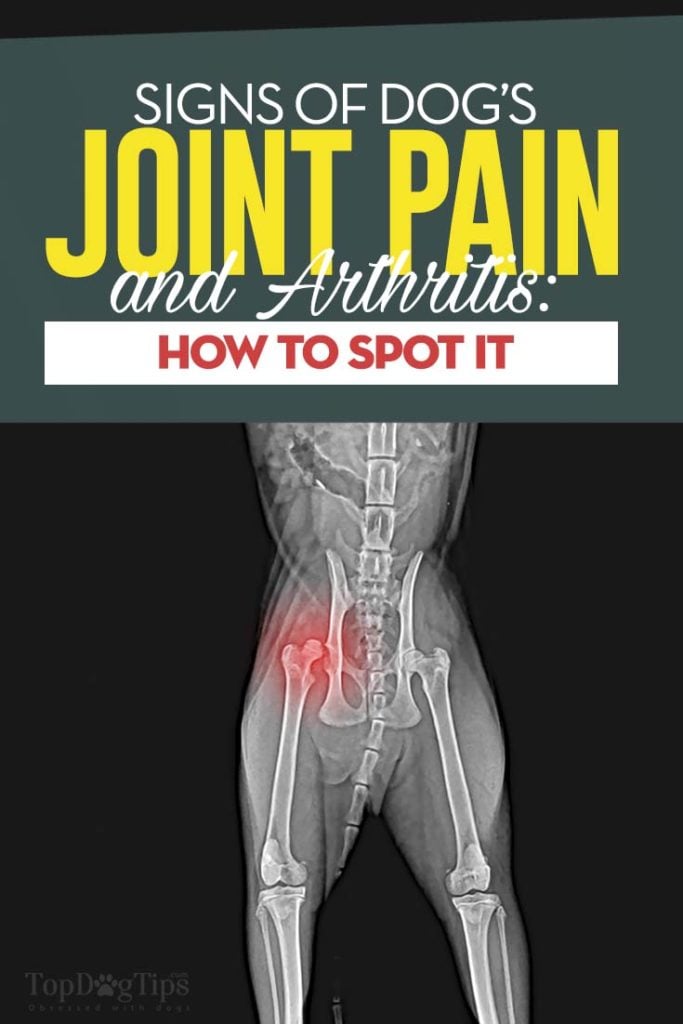Early recognition, and limiting pain and distress are two key goals of proper dog care. Unfortunately, signs of joint pain in dogs are sometimes difficult to notice until there is a major problem. Most arthritic dogs suffer in silence.
Table of Contents
To better understand the signs of dog joint pain, you need to know the types of joint diseases. These disorders that affect a dog's joints are divided as either inflammatory or noninflammatory.
Non-inflammatory joint disease results from poor conformation, trauma, or developmental disorders is the correctly termed degenerative joint disease in dogs. The most common type of non-inflammatory joint disease in dogs is rheumatoid arthritis (RA).
Inflammatory joint disease can be subdivided, based on its cause (infectious versus noninfectious) and its radiographic/histologic characteristics (erosive versus nonerosive) in arthritic dogs. The most common type of inflammatory joint disease in dogs is osteoarthritis (OA).
Although some breeds are predominantly susceptible to developmental orthopedic diseases, most common joint diseases affect all breeds and ages.
Symptoms of each disease are similar. Based on most recent studies, veterinarians predict that 20% of middle-aged dogs and 90% of older dogs (over 8 years) will have joint pain or osteoarthritis in one or more joints.
8 Signs of Joint Pain in Dogs
 1. Lameness, Inactivity, Stiffness
1. Lameness, Inactivity, Stiffness
Lameness is part of an abnormal gait or stance of an animal. By itself it is not a diagnosis, but only a clinical sign of some pathological processing of pain in the dog (1).
At the beginning of the disease, the signs are weak and characterized by a longer period of rest your dog will take after walks, or some stiffness after getting up from the floor. In more serious degree of disease, these signs are more expressed and longer lasting (2).
2. Reluctance to Exercise, Rise, Move
When your dog is avoiding what was once an enjoyable activity, or when he stopped jumping on furniture, it may be a sign of joint pain. Other examples include when the dog is lying down for longer periods of time or refuses to walk up or down the stairs (3).
This may seem to you that your dog is showing signs of pain for nothing, but it is more likely a sign of advanced disease of the locomotor system. Sometimes, other pain related problems in dogs will give the same clinical picture in the early stages, such as kidney diseases, therefore these other diseases would need to be ruled out first.
3. General Signs of Pain
Most of us understand how humans or dogs in pain behave, and how they react to anything affected by it. The same can be applied for assessing symptoms of joint pain in dogs.
Pain in advanced stages commonly occurs when touching the affected part of the dog's body. In early stages, it occurs after dog getting up in the morning or after sitting in the same position for long. A dog can defend touching the sensitive places, bite and lick the painful region trying to reduce pain, which is a clear tell-tale sign for the owner (4).
4. Swollen and Painful Joints, or Joint Effusion
The inflammatory process in a dog's joints will lead to a change in the soft tissue around the joint. These changes will result in the creation of scar tissue that will make the dog's joint stiffer, with a reduced range of motion (5).
Visually, if possible, due to the joint position in the body and anatomy, you may notice that the affected joint is bigger than the other non-affected one. But, sometimes, both joints are affected, so the discrepancy between them is not clearly noticeable.
Assessing thickening and effusions in the hip and shoulder are not possible due to the presence of the overlying muscle masses. Assessment of the range of motion should be both to assess any reduction in the normal planes of motion for a joint, for example, flexion and extension, but also to assess abnormal increases in the range of motion.
Here's a good evidence-based guide (PDF) to analyze your dog's gait. You'll see that most of the acute conditions result with fluid build-up in the joint space, causing canine joint effusion resulting painful leg fever, and sometimes a watery feeling under the skin.
5. Crepitus in the Joint
Crepitus is a medical term describing a noise or a vibration produced in the body which occurs when irregular surfaces or scar tissue rub against each other with grating or popping sounds.
Sometimes, this occurrence doesn’t have diagnostic significance, and it is very important to know that the level of crepitus in dogs does not correlate with the degree of disease. Yet still, it's one of the potential signs that your dog is experiencing joint pain.
6. Abnormal Stance While Moving
As your dog walks, his abnormal stance – a variation of Paroxysmal Dyskinesia – is one of the giveaways of something being wrong. Altered range of motion that is clearly visible to the owner, and a dog's altered gait are also clear signs of canine joint pain.
Kinematic and kinetic gait analysis of the dog will reveal many signs and symptoms (6). Altered gait is usually the asymmetric movement opposite to standard gait pattern while walking or running. Sometimes, altered gait may be recognized as limping or not standing on one foot while your pooch is trying to relieve another extremity of pain or weight.
The most effective way to spot abnormal gait in dogs is while he's running or trying to. The most common observed altered gait in dogs is often termed “bunny hopping” (see example here). As you see in the video, when the dog runs, he moves both back legs almost together, putting his weight on the hind legs, as if he's reluctant to make the rear legs touch the ground.
Note: this type of movement is generally normal in puppies as a learning process.
7. Muscle Atrophy
Muscle atrophy (muscle wasting) is defined as a decrease in the mass of the canine muscle and it is sometimes noticeable with some parts of the body getting thinner or weaker.
Obviously, skeletal muscle atrophy in dogs attributable to muscular inactivity has significant adverse functional consequences, and those can be spotted as you observe your canine (7).
The main reason for muscle wasting in dogs is a lack of physical activity, which is often a common sign of a dog experiencing pain. Because your pet avoids the use of painful body parts, those parts become atrophied (8). The usual muscles begin to atrophy in four weeks of inactivity, and you'll see some decrease in their size and shape.
8. Altered General Behavior
If your dog suddenly doesn't seem like himself, it may be another clear symptom of canine joint pain, but other possible causes would need to be ruled out first. Changes in your dog's behavior can be vary based on the individual dog, and depending on the breed and their character.
Most common behavior changes in dogs with joint pain are (9):
- Lethargy
- Depression
- Irritability and aggression when joints are touched
- Iincreased body tension or flinching in response to gentle palpation of injured area and palpation of regions likely to be painful (e.g. leg, neck, back, hips and elbows)
- Appetite loss
- Weight gain (due to not moving and exercising as usual)
The Bottom Line
A large number of dogs, particularly senior dogs and large breeds, will suffer from some kind of disorder of the locomotor system. Many of these are generally treatable with inexpensive medications, dietary improvement, weight loss and exercise. As long as you know how to spot signs of joint pain in dogs, you'll be able to fix the problem.
Other issues, such as advanced, incurable or hereditary joint related problems in dogs can be treated or managed to ensure your pet's life to be easier and pain-free, but diseases like osteoarthritis have no cure.
Nevertheless, if some of the symptoms listed above show up in your pet, and you're positive it's due to joint pain, a quick and simple treatment plan as recommended by your veterinarian could greatly improve the dog's quality of life and decrease discomfort.
READ NEXT: Dog Arthritis Massage – Its Benefits and How to Do It














